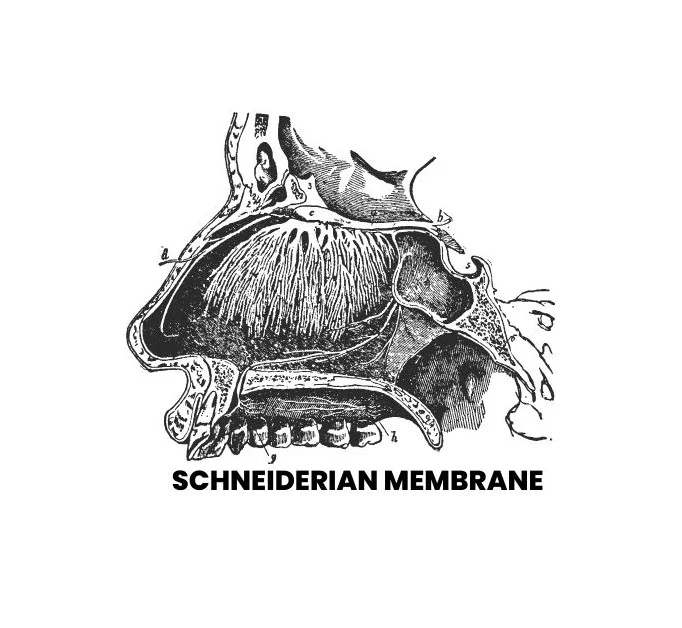
The Schneiderian membrane, also known as the Schneiderian mucosa or olfactory mucosa, is a specialized mucous membrane that lines the nasal cavity.
This membrane is named after the German anatomist and physician, Max Schneider, who made significant contributions to the understanding of nasal anatomy.
Key Characteristics of the Schneiderian Membrane
- Location
- Found within the nasal cavity and extends into the paranasal sinuses.
- Lines the walls of the nasal passages and covers the surfaces of the sinuses.
- Mucous Secretions
- Secretes mucus, which helps to moisturize and humidify the air entering the nasal passages.
- The mucus also traps dust, debris, and microorganisms, preventing them from entering the respiratory system.
- Ciliated Epithelium
- Contains ciliated epithelial cells with hair-like structures (cilia).
- Ciliary movement helps propel the mucus along the surface, assisting in the removal of trapped particles.
- Immunological Defence
- Plays a role in the immune defence of the respiratory system.
- Contains immune cells and antibodies that contribute to the body’s defense against pathogens.
- Respiratory Function
- Facilitates the process of breathing by providing a moist surface for air passage.
- Regulates the temperature and humidity of the inhaled air.
- Connection to Paranasal Sinuses
- The Schneiderian membrane extends into the paranasal sinuses, covering their interior surfaces.
- Role in Olfaction
- Contributes to the sense of smell by providing a surface for olfactory receptors.
- The olfactory epithelium, responsible for detecting odours, is part of the Schneiderian membrane.
- Responsive to Irritants
- Reacts to irritants by increasing mucus production and triggering protective mechanisms.
FREQUENTLY ASKED QUESTIONS
- What is the Schneiderian membrane, and where is it located in the body?
- The Schneiderian membrane, also known as the olfactory mucosa, is a specialized mucous membrane found in the nasal cavity and extending into the paranasal sinuses. It lines the nasal passages and sinus surfaces.
- Who is Max Schneider, and why is the membrane named after him?
- Max Schneider was a German anatomist and physician who made significant contributions to nasal anatomy. The Schneiderian membrane is named after him in recognition of his advancements in the understanding of nasal structures.
- What are the key functions of the Schneiderian membrane?
- The membrane secretes mucus to moisturize and humidify inhaled air, traps particles to prevent respiratory entry, contains ciliated cells for particle removal, contributes to immune defence, regulates air temperature and humidity, and plays a crucial role in the sense of smell.
- How does the Schneiderian membrane contribute to respiratory health?
- The membrane facilitates breathing by providing a moist surface, regulates inhaled air conditions, and extends into paranasal sinuses, covering their interior surfaces.
- What is the role of the Schneiderian membrane in olfaction?
- The Schneiderian membrane houses the olfactory epithelium responsible for detecting odours, contributing significantly to the sense of smell.
- How does the Schneiderian membrane respond to irritants?
- In the presence of irritants, the membrane reacts by increasing mucus production and triggering protective mechanisms.
- Can conditions related to the Schneiderian membrane be addressed?
- Yes, understanding its characteristics is essential for addressing conditions like chronic sinusitis or nasal congestion.
- Why is the ciliary movement of the Schneiderian membrane important?
- Ciliary movement aids in propelling mucus, assisting in the removal of trapped particles and maintaining respiratory health.
Here is the WHOLE SYLLABUS OF ANATOMY FOR 1st BHMS STUDENTS.
Understanding the characteristics and functions of the Schneiderian membrane is essential for comprehending the nasal and sinus physiology and for addressing conditions related to these structures, such as chronic sinusitis or nasal congestion.
